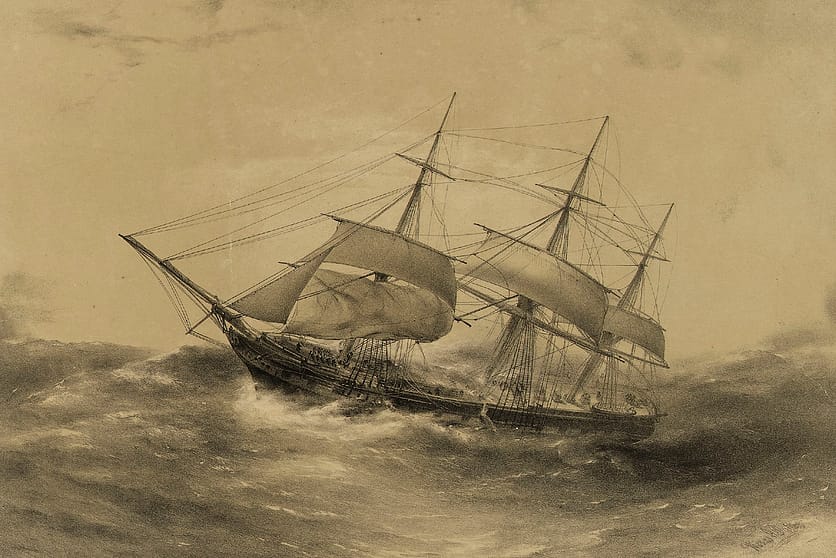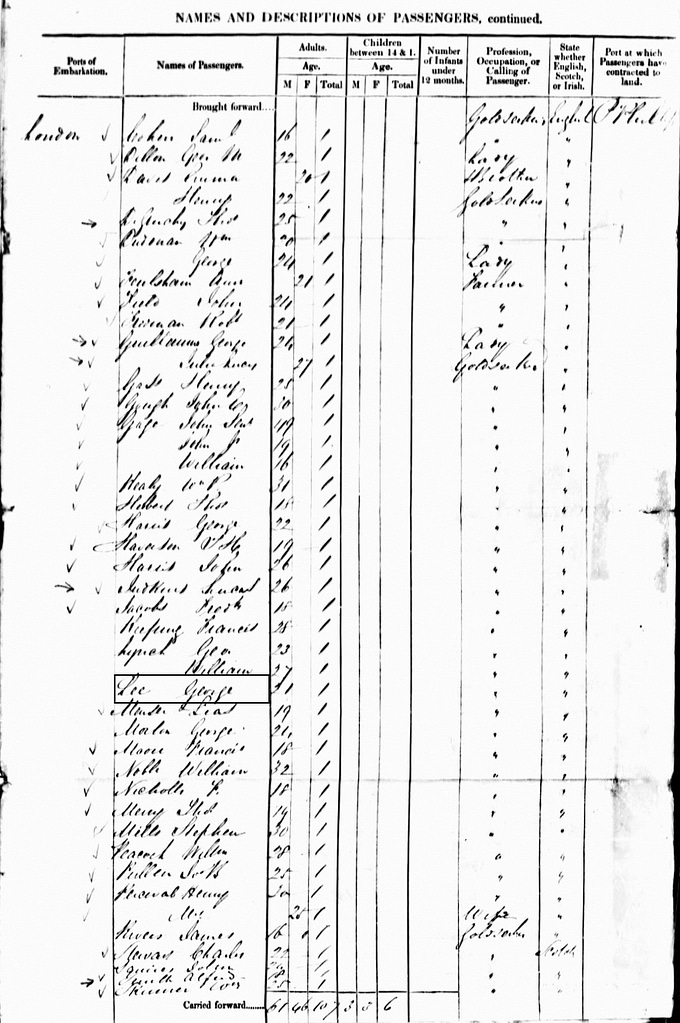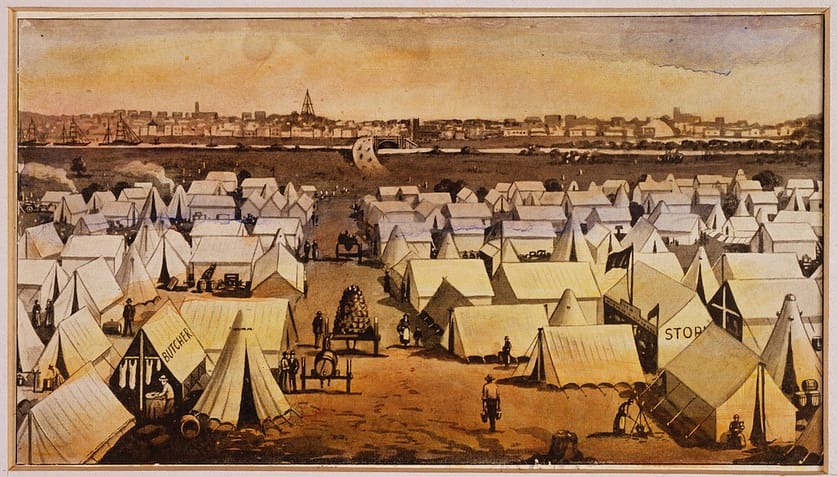As in the last post, I ‘found’ the existence of a series of letters written by a previously unknown person who names a forebear in my ancestral line. In this case, the letters were written by a George MORTON and they refer to my great grandfather’s brother, George Williams LEE (1831-1864).
George MORTON, or George M, as I’ll call him, wrote newsy letters home to his mother and sisters in England detailing his experiences on the voyage from England to Australia, his subsequent impressions of Port Phillip and the journey to the goldfields. Included in his ‘party’ is a George LEE. Following verification of this George LEE’s age and details of his life as published in future newspaper articles confirmed my hopes that this George LEE was, in fact, George Williams LEE (GWL).
Background
After learning of GWL’s existence in Australia— see post Tracing the LEE brothers, George, Edward and Charles in Australia as I’ve mentioned, I found him on the passenger list of the Blackwall on its voyage from England to Australia, arriving in Port Phillip on 9th December 1852.
An internet search for any reference to this voyage revealed a collection of letters held in the Australian National Maritime Museum, Sydney, as described on the Trove website:
1852, English, Unpublished edition: [Letters of George Morton] [to his mother and sisters, 1852, during a voyage from Plymouth to Melbourne on the ship Blackwall, and after his arrival in Victoria] / by George Morton. [manuscript] : Morton, George, 1828-1867.
George M is listed 2 names below GWL on the passenger list of the voyage I’ve described. They are just two of many young Englishmen leaving England as ‘goldseekers’.
The discovery of gold was officially announced in the newspapers in September 1851 following various finds in NSW and Victoria. 1852 was the year of the Mount Alexander goldrush which brought thousands of immigrants flocking to the diggings at Forest Creek, within sight of Mount Alexander. It is often referred to as the Mount Alexander goldrush because that was the nearest landmark for those walking up from Melbourne. George M and the others were obviously quick off the mark to get passages out to Australia.
With the faint hope that GWL may be mentioned in these letters, I requested copies. It was a long shot, but it proved to be worth it.
The excerpts of the letters I include here are as they appear in the copies of the transcripts provided.
First letter. Dated 27th September 1852
On board the Blackwall as it nears the Cape Verde Islands off West Africa.
George M is writing home to his mother and sisters back in England. Unlike the picture below the ship is almost becalmed which lengthens their journey to almost 4 months rather than the usual 3 months.

This is the first mention of George M’s fellow passenger, ‘Lee’:
We all jog along together and agree very well the six in our cabin…Our mess is divided into three “two’s”, Rivers and self, William and George Lynch, Squires and Lee…
All the names George M mentions can be identified in the passenger list of the Blackwall below:

He continues…
The first thing every morning we go to the Bowsprit and have a bath under the pump…We then get our water which is about the colour of tea, and the taste I leave to your imagination. The sediment is black as ink, with plenty of insects.
…dinner consists of either Salt pork, Beef, Preserved Beef, Mutton, Salmon, Soup. Boiled puddings, Rice or Plum or Currant Duff.
We have nothing to complain about since we left Plymouth.
Life on board doesn’t sound too bad for George M but he’s not very complimentary of the ‘Doctor’:
The Doctor on board is not liked…if you have a cold he gives Salts, if a toothache, Salts, for everything Salts, in fact he goes by the name Salts!!
‘Crossing the line’, that is the equator or Tropic of Cancer, for those doing it for the first time is a big event involving ‘traditions’ not unlike an initiation ceremony:
The sailors are preparing their ”accoutrements” for the day. We shall cross the line, a great many of the passengers do not like the thought of it at all, the sailors have made a list of fines for those who do not wish to be shaved 20/- first class, 10/- second class, 5/- third class. I think I shall undergo the operation just for the fun of the thing. They have three qualities of razors, the first is smooth, 2nd notched, 3rd like a saw. They use flour and rough tar, and woe betide those who have offended them. After shaving they either souse you with buckets of water or turn you into the tubs.
Sounds like something to be avoided.
He goes on to talk about the beautiful weather and he infers they are generally enjoying the voyage. The letter also includes some laundry details that will no doubt stir the readers’ olfactory senses:
We find it best to wash as we wear, for it only makes the cabin unpleasant, we have enough smells without dirty clothes.
Second Letter. Dated 9th December 1852 (including 11th Dec)
A safe arrival at Port Phillip:
I thank God we have arrived safe and well and in good spirits…I had the most splendid sight I ever saw this morning on entering the Bay. We were up at 4 o’clock. We could just see the two heads of the Bay sailing along by Cape Otway and gradually getting nearer and nearer till we arrived at the Entrance. You should have seen the anxiety of the Captain as he watched our crossing the Bar, the sea was rolling tremendously but in a few hundred yards it was as calm as a mill pond.
George M then mentions the disturbing sight of wrecks in the bay and continues on with a very complimentary report of what he sees…
The scenery is magnificent, the hills rising one above the other and thickly studded with trees. This Bay I should say one of the finest in the world, there is great danger in entering it owing to the sand banks which leave only a narrow channel for ships to pass.
Dated 11th December 1852
George M talks of the lack of accommodation in Melbourne and its prohibitive cost:
We have been walking about the town all the morning in search of lodgings but cannot find any. They asked £2-0-0. and £2-10-0 for an empty room, £6-0-0 a week for two empty rooms.
They had to pitch their tent instead. Food is also expensive…
We shall be ruined if we stop in town. We must go up to the Diggings direct.
Third Letter. Dated 2nd January 1853. ‘Collingwood near Melbourne’
George M and his mates have now moved to the outskirts of Melbourne in readiness to hit the road to the goldfields:
We struck our tent last night and came to sleep here till Monday morning, then we shall be off to the “Diggins”.
After dropping anchor on the 9th. Dec. George Lynch and I went on shore and walked to Melbourne and called on Miss Rogers to get all the information we could, and then to The Post Office, but there were no letters.
George M is frustrated by the poor management of the postal service, with a mention of GWL:
They will deliver letters to anyone of the same name without enquiries. I went the other day for myself and with written orders from the rest. I received three for George Lee but neither were for him one of which contained a Post Bill from the Bank for £300 so I leave you to guess why not it is safe to send money by that means. I am very glad I brought some out in gold as they charge 20 per cent for changing Bank of England notes.
The mention of ‘George Lee’ infers they have stayed together since arriving in Port Phillip.
George M then doubles back and relays to his mother and sisters their ‘doings’ since arriving on the 9th December. They set up camp in Canvas Town, now South Melbourne:

…(we) pitched our tent in Canvas Town where there were between four and five thousand people, some residents, others coming and going to the diggings or to work in the town. We paid five shillings a week for ground rent and our board did not cost us more than ten shillings per week each, so that a man can live in this way and earn his five, six or seven pounds a week, as Carpenters, Builders, Bricklayers and Masons or any Mechanics. Most of our fellow passengers have been, and are now paying their 2 or three pounds a week for board and lodgings.
He relays their plans for going up north to the Mount Alexander goldfields:
We have hired a dray which will take us up to Forest Creek for £1-0-0 per cwt. We shall walk by its side, it takes rather more than three days to walk (the distance is about 80 miles) and then we shall require day or two’s rest before we begin to work.
We have had hot winds and land storms which must be seen and felt to be believed and the weather just as change-able as in England. The flys (sic) are a perfect nuisance, they attack ones face and there’s no driving them off…
That hasn’t changed George…
There is always much affection in his letters, asking to be remembered to this one and that.
Fourth Letter. Dated 25th March 1853. ‘Collingwood near Melbourne’

At the time of this letter, the last in the collection, George M is back in Melbourne. It’s just over 2 months since they left for the goldfields. There is a different tone in this letter to the others. He sounds homesick and disillusioned:
My thoughts are always at home, how much I should like to spend this day in your society. Well we may say “There’s no place like home” for there is but little comfort here. To make money and then return to dear old England is the business of our lives.
He gives details of their trek to the goldfields, leaving Melbourne nearly a month after arriving. GWL is mentioned once again:
We made our start to the Diggings (Mt. Alexander) on the 3rd Jan. at 4pm. walked 12 miles, our dray was well loaded (1100lbs.) having two, horses in the shafts, one of which was worse than useless so we had to push as well as walk the whole journey. To begin our hardships G. Lee and I had our hammocks stolen from the dray with their contents the consequence was that for nearly a month I slept without taking off my clothes and with no other covering.

George M goes on…
The nights were bitterly cold, and the days extreemly hot. (sic) The scenery was very good but walking 20 to 25 miles, a day after being cramped up in a ship for four months prevented our enjoying it. We encamped one night at the foot of Mt. Macedon in the Black Forest. We all lay under the cart with a tarpaulin thrown over it, but I was miserably cold and was glad to make a fire and lie by it.

We reached Pennyweight Flat, Forest Creek on Friday at 4pm. Rested Saturday and Sunday and procured our licences and began work under the direction of Capt. Rogers and his mates.
It was not prosperous…
We all worked hard the month of January and did not get enough to pay for our food. It was quite a break to get a dry hole, we were sometimes for two or three hours pulling water up and perhaps when near the top the bucket would upset and we should be wet for the rest of the day.
Sounds miserable.
According to the next part of the letter the cabin mates from the Blackwall, George M, GWL and the ‘two Lynches’, have stuck together on the diggings:
The first part of the month G. Lee and I worked together, and the two Lynches, but our hole had water constantly coming in, so that we were obliged to give it up and then we all worked together at the same hole thirty feet deep. The bottom of it was as if it had been burnt and cemented together through some volcanic agency and I believe it has been. This month we took out about half a pound of gold from the hole which covered our expenses at the Diggings. We then sold our tent and tools and returned to Melbourne to see whether we could do better at business than the Diggings.
It sounds increasingly miserable and tough work for little reward.
On his return to Melbourne, George M stays with passengers he met on the ship and helps his landlord out with painting. There’s no other mention of GWL.
Despite George M’s disillusionment with the new colony he didn’t return to his home country, England. Instead, he married just 6 months after writing the last letter in this collection. He stayed and raised a family and spent the rest of his life in Australia.
He married Emily ROGERS, the daughter of Captain ROGERS (see the fourth letter), on the 21 September 1853 and served as the Sheriff’s clerk in Castlemaine for the next 14 years. He died on 12 Nov 1867 aged 39 years, just three years after his fellow passenger, George Williams LEE.
I don’t know if GWL stayed on at the goldfields at this time or whether he returned to Melbourne with George M. Further research informs that GWL stayed in Australia and travelled all over Victoria having a go at puddling on other goldfields, doing a bit of carpentry and generally experiencing every aspect of the new frontier. He dabbled in reporting and politics, being nominated as a candidate for the seat of North Gippsland in the election of 1861 in Victoria. He fought for the 8 hour day and was keen to break up the squatters’ land so that agriculture could move in, providing food and jobs for the growing population. More of him later…

A week ago, I visited the Forest Creek Diggings. The public have access to a portion of the area which is cordoned off for educational purposes. The site is sign-posted on the Pyrenees Highway between Chewton and Castlemaine.
The day was hot and oppressive. Bullants scurried around my feet, diving frenetically in and out of tiny holes in the red, gravelly dirt. These ants were genetically adapted to the harsh conditions unlike the young Londoners, who would no doubt have suffered from sunburn and heat stroke as they dug down ever further into the unforgiving creek bed hoping with each strike of the pick to reveal the yellow metal.
As I scoured the surrounding battered and scarred landscape I couldn’t help thinking of the local Aboriginal people, the Jaara, or Djadjawurrung speaking people, who must have been perplexed by the invasion of thousands of frenzied, pale beings gouging out the country. The impact on the landscape was immense; for instance, the miners’ activities silted up the streams destroying the Jaara’s supply of drinking water.

The London papers were incredulous that the Jaara had not known they were sitting on a fortune, a fortune that could have made them ‘the most powerful race under the sun’. But of course gold meant nothing to them; it was not their currency. It was a fine example of the ignorance of the far off English journalists.
I was soon brought back to the present by the soft, privileged voice of Justin Bieber ringing out across the gullies from a far off radio turned up to the max and by popping firecrackers heralding in the year of the monkey. Perhaps the spirits of some of the Chinese gold diggers were letting me know they were here too. In fact, there’s a faded sign on the top of the cliff in the photo above which says, translated from the Chinese, ‘Gold found here’. I suppose each looked after their own.
It was and is a harsh landscape. I can almost understand why James and Thirzah WINTER ‘took to the drink’.
The inherent value of these newsy letters written by George MORTON is that they give a wonderful insight into the goldrush and as a personal benefit they add to the migration story of George Williams LEE. Unfortunately, the joy of the discovery is dampened somewhat by the sight of the scarred landscape at Forest Creek and the consequent impact the activity of the miners had on the Jaara. Seeing the site was educational for me in more ways than one.
A well told family story, told in a way that makes it interesting for non-family members.
Thanks for the comment boundforoz. Much appreciated. It’s always a challenge to make the stories interesting and entertaining for ‘others’.